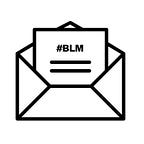Why we are publishing a new edition of Letters for Black Lives
Letters for Black Lives is fundamentally an expression of love and solidarity.
It is an expression of love for our families and our communities. Love for our Black family members and friends. And solidarity with the Black community whom we have seen stand up to injustice around the world to fight for equity.
But it is also an expression of sadness and anger.
If you remember the previous letter, it started when Philando Castile was shot in 2016. It was rumored that the cop was Asian American and we saw how the Peter Liang case had polarized the Chinese American community. We saw how we needed to confront anti-Blackness in our communities. So Letters for Black Lives was born as a way to kickstart those conversations.
Since then we’ve had four years of increased racism within the US and another rise of white supremacy around the world. And then we are now moving into the fifth month of a global pandemic where Black and Indigenous communities — which have historically been underserved — are disproportionately affected by the lack of healthcare and other social resources. And then an Asian American police officer stood guard while George Floyd was murdered by a cop. And now there are already those who are calling for him to have the protections of white supremacy. We see people across the US and around the world marching and protesting for George Floyd, for Dreasjon Reed, for Tony McDade, for Breonna Taylor, for Ahmaud Arbery, and all the Black families demanding justice despite the dangers of coronavirus.
And so more people showed up, the context changed, and people were angrier, so the community wrote another letter because we cannot stay quiet while those in our community literally stand for white supremacy.
Thanks to the momentous efforts of more than 330 translators over the last 10 days, we are publishing our first set of letters in 26 languages:
Albanian, Armenian (Eastern), Bangla, Bosnian, Burmese, Chinese (Simplified), Chinese (Traditional), Croatian, French, German, Greek, Hmong, Indonesian, Japanese, Khmer, Korean, Lao, Nepali, Persian, Polish, Portuguese (Brazilian), Spanish, Sylheti, Tagalog, and Turkish.
There is still more that needs help: There are more than 40 in the works — with letters for families in Canada and around the world — many written for their community’s specific context and history. Like last time, there are efforts to create recordings of the letters in our own tongues. New this year is an effort to connect volunteer translators to organizations that have been serving our communities on the ground.
Letters for Black Lives is also an expression of hope. Hope that our families can change, that we can find shared understanding to work together to build a better future. Because without that love we would not try. Without that hope we would give up on our family and march on alone. We came back to write this new letter because we are sad and angry, but also because we are full of love for our families and have hope for a more just and equitable world.
